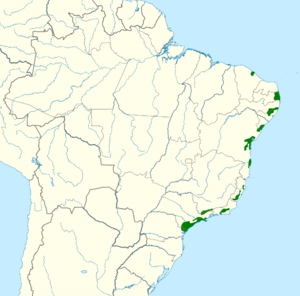Golden-tailed parrotlet facts for kids
Quick facts for kids Golden-tailed parrotlet |
|
|---|---|
 |
|
| Conservation status | |
| Scientific classification | |
| Genus: |
Touit
|
| Species: |
surdus
|
 |
|
| Synonyms | |
|
Touit surda (lapsus) |
|
The golden-tailed parrotlet (Touit surdus) is a small, colorful bird. It belongs to the parrot family, which includes parrots from Africa and the Americas. This special bird lives only in eastern Brazil. It is considered a Vulnerable species, meaning it needs our help to survive.
Contents
About This Parrotlet
This parrotlet is quite unique. Scientists currently consider it the only type of golden-tailed parrotlet. However, researchers are still studying if the parrotlets living in the northern part of Brazil might be a slightly different group.
What It Looks Like
The golden-tailed parrotlet is about 16 centimeters (6.3 inches) long. Its body is mostly green, with darker green feathers on its back. The feathers on its rump and upper tail are a bright emerald green.
- Head: Its forehead, the area between its eyes and beak (lores), and its cheeks are yellow. It also has a white ring around its eyes.
- Wings: The feathers on its shoulders (scapulars) are olive-brown. Its main flight feathers are dark brown with green edges. Other wing feathers are green, and the area near its wrist (carpal area) is blue.
- Tail: Male parrotlets have green central tail feathers. The other tail feathers are greenish-yellow, and all have narrow black tips. Female parrotlets look very similar to males. Their colors are a bit duller underneath, and their tail feathers are greener.
Where It Lives
The golden-tailed parrotlet lives in different areas of eastern Brazil. You can find it in the state of Ceará. It also lives in parts of Pernambuco and Alagoas. Another area it calls home is between Bahia and São Paulo state.
This parrotlet likes humid evergreen forests. It also lives in forests with sandy soils. It can be found in both old, untouched forests and newer forests that have grown back. Sometimes, it even visits cacao plantations. In higher, inland areas, it lives in the lower parts of mountain forests. It can be found from sea level up to about 900 or 1000 meters (2,950 to 3,280 feet) high.
Behavior
Movement
Scientists have noticed that golden-tailed parrotlets move around during certain seasons. However, these movements are not fully understood yet.
Feeding Habits
Golden-tailed parrotlets usually look for food in small groups. These groups are likely made up of family members. Their diet mainly consists of fruit, but scientists are still learning more about what specific fruits they eat.
Reproduction
It is thought that golden-tailed parrotlets start their breeding season in September or October. This is usually when the rainy season begins. The only nests ever found were inside termite nests in trees. We don't know how many eggs they lay, how long the eggs take to hatch, or how long it takes for the young birds to leave the nest. Details about how the parents care for their chicks are also unknown.
Vocalization
The call of the golden-tailed parrotlet sounds like a high-pitched "kree-kree-kree-kruh-" or a loud, shrieking "k'reeéh."
Status and Conservation
The IUCN (International Union for Conservation of Nature) first listed the golden-tailed parrotlet as "Threatened." Then, in 1994, it was changed to "Endangered." Since 2004, it has been classified as "Vulnerable."
- Why it's vulnerable: This parrotlet lives in a very small area. There are fewer than 10,000 adult birds left, and their numbers are believed to be decreasing. A major reason for this is the widespread cutting down of forests where they live.
- Hope for the future: Even though forests are being lost, scientists have found that this parrotlet can adapt better to fragmented forests than first thought. It might also be more common than we realize, especially in the southern parts of its range. Luckily, it lives in many protected areas, including both private and government reserves.


